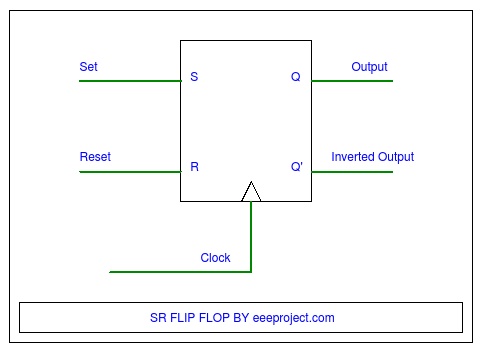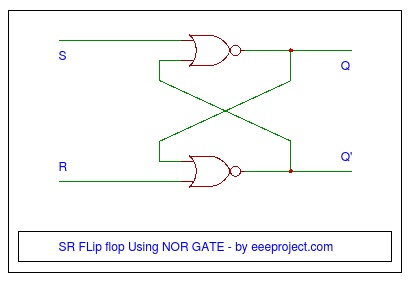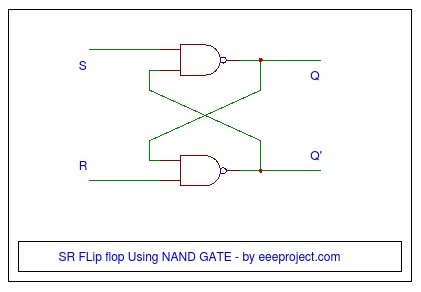SR flip flop
In SR flip flop, S stands for ‘set input’ and R stands for ‘reset input’. It is basically a simple arrangement of logic gates that is used to maintain a stable output even if the inputs are switched off. It is also referred to as a SR Latch, because it is one of the most important and simple sequential logic circuits possible.

What are flip flop?
Flip flop are also known as a latch. This term lies in the study of electronics. It is a circuit which has two stable states that is why it is also called a bistable multivibrator. This circuit is also used to store the state information. The main storage element or unit of sequential logic is the flip flop.
The term flip flop basically means simple and synchronous that is clocked circuits.
SR flip flop consists of :
This simple sequential circuit mainly consists of two important gates which are connected to each other in a way that they it works as a bistable multivibrator.
- It can be made by using different logic gates. The most commonly used logic gates for this circuit are NAND and NOR gates.
- The circuit of SR flip flop is completed or connected in such a way that the output of both the gates is connected to back to the input unit of the other or corresponding gate.
- This kind of connection is referred to as cross coupling which usually gives a positive feedback.
- The top output which is also referred to as set input (S) gives the result output of 0.
- And, the bottom output of the set input also gives another result output of 1.
- And, the result of the reset input (R) input is completely opposite of the set input that is top output is 1 and bottom output is 0.
- The two bistable states of this circuit are low (0) and high (1).
- Due to these stable and reset inputs, it is referred to as SET-RESET flip flop.
- The output state of this circuit changes when both the input signals S and R complement each other.
Type of SR flip flop :
There can be two type of SR flip flop described below.
- SR flip flop with NOR gate
- SR flip flop with NAND gate
Both SR flip flop differ in their working because of the presence of different logic gates.

This circuit can stay in one state until; there comes an input signal to switch on the latch.

Uses of SR flip flops:
- It is used to keep a record of different values of variable state like intermediate, input or output.
- It is mainly used to store data or information.
- Wherever operations, storage and sequencing are required these signal circuits are used.
- They are also used for excising control over the way the circuit has to function, like for changing the operation of a circuit to a different state.
You may also like the JK Flip flop
Applications of SR flip flop
- The most important application of these types of sequential circuits is that they are used for switching on the simple circuits which work on set or reset mechanism. The example of such circuit where they are used is Switch de-bounce circuit.
- These are also used for eliminating mechanical bounce of the switches present in the digital circuits.
- It is also used as digital latching relay.
You may also like to see sun tracking solar panel circuit
Problem associated with SR flip flops
The main problem associated with these circuits is that they work on simple 1-bit memory, so if set input is first taken as 0 then taken back to logic, and then the further change does not have any effect on logic 0 pulses of set input (S).
You may also like the working of Automatic Emergency Light

14 thoughts on “SR flip flop [Explained] in detail”
Please add truthtable for sr flipflop
We will update the article with better information and the truth table later.
Vary nice
I need to make sr flip flop using nand gate. Please help me
What kind of help do you need Tarun ?
Hi there, I enjoy reading your other article.
I wanted to write a little comment to support you.
Thanks for your support Ashley. Will update the SR flip flop too..
Hey, what’s the difference between flip flops and latches?
Application of SR flipflop short notes
Very nice
It supports for my lecture time.
Thanks
Thanks! Glad that helped… 🙂
i am an eee student studying in btech 3rd year can you just me a project
What’s the difference btn a latch and flipflop
Hi, I really enjoyed this article however feel as though It needs improving as some of the facts are invalid and are incorrect. I am a leading computer scientist and find this article extremely damaging to our industry as it displays incorrect facts throughout. I am surprised that this article was even allowed to be published.
Kind Regards
Theodore